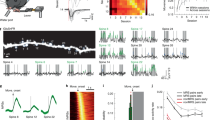Abstract
Changes in synaptic connections are considered essential for learning and memory formation1,2,3,4,5,6. However, it is unknown how neural circuits undergo continuous synaptic changes during learning while maintaining lifelong memories. Here we show, by following postsynaptic dendritic spines over time in the mouse cortex7,8, that learning and novel sensory experience lead to spine formation and elimination by a protracted process. The extent of spine remodelling correlates with behavioural improvement after learning, suggesting a crucial role of synaptic structural plasticity in memory formation. Importantly, a small fraction of new spines induced by novel experience, together with most spines formed early during development and surviving experience-dependent elimination, are preserved and provide a structural basis for memory retention throughout the entire life of an animal. These studies indicate that learning and daily sensory experience leave minute but permanent marks on cortical connections and suggest that lifelong memories are stored in largely stably connected synaptic networks.
This is a preview of subscription content, access via your institution
Access options
Subscribe to this journal
Receive 51 print issues and online access
$199.00 per year
only $3.90 per issue
Buy this article
- Purchase on Springer Link
- Instant access to full article PDF
Prices may be subject to local taxes which are calculated during checkout





Similar content being viewed by others
References
Bailey, C. H. & Kandel, E. R. Structural changes accompanying memory storage. Annu. Rev. Physiol. 55, 397–426 (1993)
Buonomano, D. V. & Merzenich, M. M. Cortical plasticity: from synapses to maps. Annu. Rev. Neurosci. 21, 149–186 (1998)
Changeux, J. P. & Danchin, A. Selective stabilisation of developing synapses as a mechanism for the specification of neuronal networks. Nature 264, 705–712 (1976)
Hubel, D. H., Wiesel, T. N. & LeVay, S. Plasticity of ocular dominance columns in monkey striate cortex. Phil. Trans. R. Soc. Lond. B 278, 377–409 (1977)
Lichtman, J. W. & Colman, H. Synapse elimination and indelible memory. Neuron 25, 269–278 (2000)
Shatz, C. J. & Stryker, M. P. Ocular dominance in layer IV of the cat’s visual cortex and the effects of monocular deprivation. J. Physiol. (Lond.) 281, 267–283 (1978)
Grutzendler, J., Kasthuri, N. & Gan, W. B. Long-term dendritic spine stability in the adult cortex. Nature 420, 812–816 (2002)
Zuo, Y., Lin, A., Chang, P. & Gan, W. B. Development of long-term dendritic spine stability in diverse regions of cerebral cortex. Neuron 46, 181–189 (2005)
Zuo, Y., Yang, G., Kwon, E. & Gan, W. B. Long-term sensory deprivation prevents dendritic spine loss in primary somatosensory cortex. Nature 436, 261–265 (2005)
Purves, D. & Hadley, R. D. Changes in the dendritic branching of adult mammalian neurones revealed by repeated imaging in situ . Nature 315, 404–406 (1985)
Trachtenberg, J. T. et al. Long-term in vivo imaging of experience-dependent synaptic plasticity in adult cortex. Nature 420, 788–794 (2002)
Darian-Smith, C. & Gilbert, C. D. Axonal sprouting accompanies functional reorganization in adult cat striate cortex. Nature 368, 737–740 (1994)
Sin, W. C., Haas, K., Ruthazer, E. S. & Cline, H. T. Dendrite growth increased by visual activity requires NMDA receptor and Rho GTPases. Nature 419, 475–480 (2002)
Kleim, J. A., Vij, K., Ballard, D. H. & Greenough, W. T. Learning-dependent synaptic modifications in the cerebellar cortex of the adult rat persist for at least four weeks. J. Neurosci. 17, 717–721 (1997)
Hofer, S. B., Mrsic-Flogel, T. D., Bonhoeffer, T. & Hubener, M. Experience leaves a lasting structural trace in cortical circuits. Nature 457, 313–317 (2009)
Holtmaat, A., Wilbrecht, L., Knott, G. W., Welker, E. & Svoboda, K. Experience-dependent and cell-type-specific spine growth in the neocortex. Nature 441, 979–983 (2006)
Dunaevsky, A., Tashiro, A., Majewska, A., Mason, C. & Yuste, R. Developmental regulation of spine motility in the mammalian central nervous system. Proc. Natl Acad. Sci. USA 96, 13438–13443 (1999)
Matsuzaki, M., Honkura, N., Ellis-Davies, G. C. & Kasai, H. M. Structural basis of long-term potentiation in single dendritic spines. Nature 429, 761–766 (2004)
Toni, N., Buchs, P. A., Nikonenko, I., Bron, C. R. & Muller, D. LTP promotes formation of multiple spine synapses between a single axon terminal and a dendrite. Nature 402, 421–425 (1999)
Costa, R. M., Cohen, D. & Nicolelis, M. A. Differential corticostriatal plasticity during fast and slow motor skill learning in mice. Curr. Biol. 14, 1124–1134 (2004)
Denk, W., Strickler, J. H. & Webb, W. W. Two-photon laser scanning fluorescence microscopy. Science 248, 73–76 (1990)
Karni, A. et al. The acquisition of skilled motor performance: fast and slow experience-driven changes in primary motor cortex. Proc. Natl Acad. Sci. USA 95, 861–868 (1998)
Buitrago, M. M., Schulz, J. B., Dichgans, J. & Luft, A. R. Short and long-term motor skill learning in an accelerated rotarod training paradigm. Neurobiol. Learn. Mem. 81, 211–216 (2004)
Ziv, N. E. & Smith, S. J. Evidence for a role of dendritic filopodia in synaptogenesis and spine formation. Neuron 17, 91–102 (1996)
Karni, A. & Sagi, D. The time course of learning a visual skill. Nature 365, 250–252 (1993)
Celikel, T. & Sakmann, B. Sensory integration across space and in time for decision making in the somatosensory system of rodents. Proc. Natl Acad. Sci. USA 104, 1395–1400 (2007)
Arenz, A., Silver, R. A., Schaefer, A. T. & Margrie, T. W. The contribution of single synapses to sensory representation in vivo . Science 321, 977–980 (2008)
Houweling, A. R. & Brecht, M. Behavioural report of single neuron stimulation in somatosensory cortex. Nature 451, 65–68 (2008)
Huttenlocher, P. R. & Dabholkar, A. S. Regional differences in synaptogenesis in human cerebral cortex. J. Comp. Neurol. 387, 167–178 (1997)
Rakic, P., Bourgeois, J. P., Eckenhoff, M. F., Zecevic, N. & Goldman-Rakic, P. S. Concurrent overproduction of synapses in diverse regions of the primate cerebral cortex. Science 232, 232–235 (1986)
Li, C. X. & Waters, R. S. Organization of the mouse motor cortex studied by retrograde tracing and intracortical microstimulation (ICMS) mapping. Can. J. Neurol. Sci. 18, 28–38 (1991)
Anderson, B. J., Eckburg, P. B. & Relucio, K. I. Alterations in the thickness of motor cortical subregions after motor-skill learning and exercise. Learn. Mem. 9, 1–9 (2002)
Diamond, M. C. et al. Increases in cortical depth and glia numbers in rats subjected to enriched environment. J. Comp. Neurol. 128, 117–126 (1966)
Grossman, A. W., Churchill, J. D., Bates, K. E., Kleim, J. A. & Greenough, W. T. A brain adaptation view of plasticity: is synaptic plasticity an overly limited concept? Prog. Brain Res. 138, 91–108 (2002)
Kleim, J. A., Pipitone, M. A., Czerlanis, C. & Greenough, W. T. Structural stability within the lateral cerebellar nucleus of the rat following complex motor learning. Neurobiol. Learn. Mem. 69, 290–306 (1998)
Acknowledgements
This work was supported by National Institutes of Health R01 NS047325 and a Dart Foundation Fellowship to W.-B.G. and by an Ellison/AFAR Postdoctoral Fellowship to G.Y. We thank members of the Gan laboratory for their comments.
Author Contributions G.Y. and W.-B.G. conceived the experiments. G.Y. performed and analysed most experiments on motor cortex and all the experiments on barrel cortex. F.P. conducted and analysed some of the experiments on motor cortex. G.Y. and W.-B.G. performed the data fitting. W.-B.G. wrote the manuscript.
Author information
Authors and Affiliations
Corresponding author
Supplementary information
Supplementary Information
This file contains Supplementary Figures 1-7 with Legends, Supplementary Tables a and b, Supplementary Data, a Supplementary Discussion and Supplementary References. (PDF 539 kb)
Supplementary Movie 1
This movie file shows mice in Cage 1 which is a bead-string hanging enriched cage in which 200 strings of plastic beads were evenly hung from the top of the cage grid. The mice need to navigate through the bead-strings to get access to food and water. (MOV 8759 kb)
Supplementary Movie 2
This movie file shows mice in Cage 2 which is a bead-string hanging enriched cage in which 200 strings of plastic beads were evenly hung from the top of the cage grid. The mice need to navigate through the bead-strings to get access to food and water. (MOV 9169 kb)
Rights and permissions
About this article
Cite this article
Yang, G., Pan, F. & Gan, WB. Stably maintained dendritic spines are associated with lifelong memories . Nature 462, 920–924 (2009). https://doi.org/10.1038/nature08577
Received:
Accepted:
Published:
Issue Date:
DOI: https://doi.org/10.1038/nature08577
This article is cited by
-
A sleep-active basalocortical pathway crucial for generation and maintenance of chronic pain
Nature Neuroscience (2023)
-
Information encoded in volumes and areas of dendritic spines is nearly maximal across mammalian brains
Scientific Reports (2023)
-
Neocortical synaptic engrams for remote contextual memories
Nature Neuroscience (2023)
-
Training-induced circuit-specific excitatory synaptogenesis in mice is required for effort control
Nature Communications (2023)
-
Chronic low-dose Δ9-tetrahydrocannabinol (THC) treatment stabilizes dendritic spines in 18-month-old mice
Scientific Reports (2023)
Comments
By submitting a comment you agree to abide by our Terms and Community Guidelines. If you find something abusive or that does not comply with our terms or guidelines please flag it as inappropriate.



